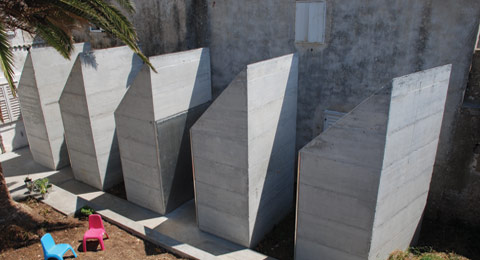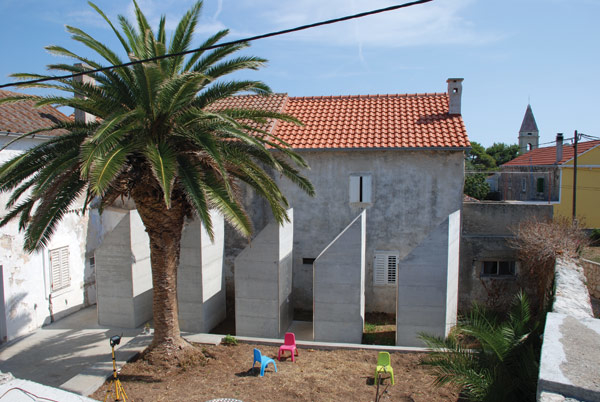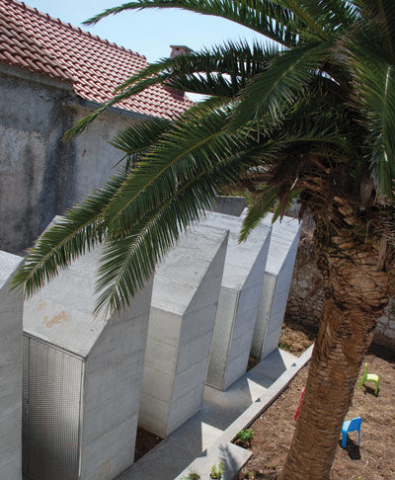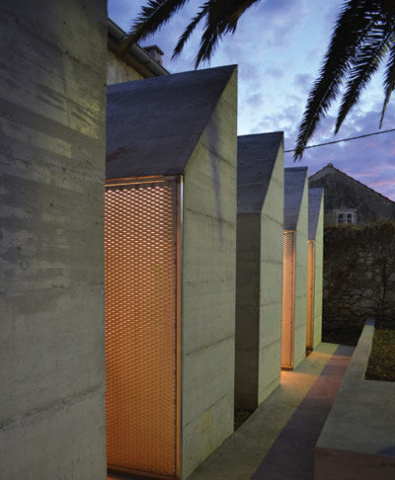Lokacija: otok Silba
Investitor: privatni
Autor: Iva Letilović, Igor Pedišić
Fotograf: Igor Pedišić
Godina projektiranja: 2011.
Godina dovršetka gradnje: 2011.
Izvođač: privatni
Površina lokacije: 150 m²
Ukupna tlocrtna površina: 7,5 m²
Troškovi gradnje (kn/m²): 3.500 kn/m²
Projekt je nastao u dvoru tipične silbanjske kuće izgrađene pred više od jednog stoljeća, kuće bez vode i kanalizacije, bez sanitarnog čvora i kupaonice! Kuća i dvor smješteni su u centru starog dijela naselja čiju urbanističku strukturu čine organski multiplicirane upravo takve stambene jedinice.
Dvor je omeđen kućom kojoj pripada, susjednim dvorom, putem i kućom kojoj ne pripada. Ova potonja zauzima najdužu frontu dvora i unosi zabunu u percepciju vlasničkih odnosa. Ista ima nekoliko manjih otvora orijentiranih na dvor, te tako prisvaja i dio njegove intime. Nelagoda je zapravo uzajamna, bilo pojavna, zvučna ili mirisna.
Projektni zadatak je bio vrlo banalan: trebalo je riješiti bazičnu stambenu infrastrukturu, na otoku bez tekuće vode i kanalizacije. Dakle, trebalo je izgraditi gusternu, septičku jamu i sadržaje koji se na to naslanjaju te kuću osposobiti za ljetno korištenje.
5 kućica (tlocrtnih dimenzija cca 1×1,5m) izgrađenih u dvoru zapravo je ponavljanje već gotovo arhetipskog principa gradnje na ovim prostorima: princip koji servisnim i strogo utilitarnim sadržajima nemilice izgrađuje, dograđuje, prigrađuje dvorišni prostor. U ovome slučaju, niz identičnih betonskih volumena multipliciran je u pravilnom ritmu. Svaka kućica zasebno udomljuje po jedan „nereprezentativan“ sadržaj (roštilj, prostor za hidrofor, perilicu za rublje i bojler, sanitarni čvor, tuš i spremište za alat), a sve one zajedno oduzimaju prvenstvo kući kojoj ovo dvorište ne pripada, istovremeno poštujući dosjelo pravo njezinih otvora.
Izgrađene su od betona, materijala koji vremenom stari, poput kamena ili poput žbukanog zida sa ispranom bojom nanešenom pred jedno stoljeće. Tijekom dana, sunce na svom putu od istoka do zapada, izmjenama svjetla i sjene pokreće ovaj niz kućica i iz sata u sat stvara novu sliku.
Location: the Island of Silba
Client: private
Author: Iva Letilović, Igor Pedišić
Photo: Igor Pedišić
Design: 2011
Completion: 2011
Contractor: private
Site area: 150 m²
Total layout area: 7.5 m²
Construction costs: 3.500 kn/m²
The project was realized in the court of Silbia’s typical house, built more then a century ago, without running water, sewage, and sanitary facilities. The house and yard are located in the centre of the old urban settlement whose structure consists of organically multiplying similar housing units.
The place is surrounded with the house it belongs to, the neighboring yard, a road and a house it does not belong to. The latter occupies the longest front of the yard and confuses the perception of the ownership. That house has a few small openings overlooking the yard, and, by appropriating part of its intimacy it creates a mutual discomfort of sharing visual, auditory and olfactory occurrences in the yard.
The terms of reference were simple – one had to solve the basic housing infrastructure on an island with no running water and sewage – a water tank, septic tank, and the content that follows were to be built and the house fitted for the summer use.
Five small structures (ground floor plan dimensions 1×1.5m) were constructed in the yard, on the bases of the old archetypal principle of repetition. It is the principle that relentlessly builds, upgrades, partitions and adds strictly utilitarian facilities. In this case a number of identical concrete volumes multiplied in a regular rhythm. Each volume is a home to one “unrepresentative” content (grill, space for water pump, washing machine and water heater, toilet, shower and a storage for tools). Together they take away the supremacy of the house the yard does not belong to, while still respecting the right of its openings.
The structures were built of concrete, the material that ages with time like the rock or a white-washed wall with a century old fading colour. During the day the sun, on its way from East to West, casts light and shadows on them creating a new picture from hour to hour.









